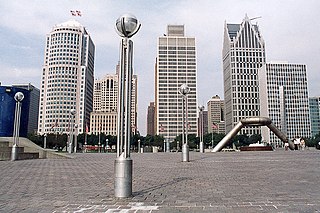
Fisting—also known as fist fucking (FF), handballing, and brachioproctic or brachiovaginal insertion—is a sexual activity that involves inserting one or more hands into the rectum or the vagina. Fisting may be performed on oneself (self-fisting) or performed on one person by another. People who engage in fisting are often called "fisters".

Adolph Alexander Weinman was a German-born American sculptor and architectural sculptor.

Carl Milles was a Swedish sculptor. He was married to artist Olga Milles and brother to Ruth Milles and half-brother to the architect Evert Milles. Carl Milles sculpted the Gustaf Vasa statue at the Stockholm Nordic Museum, the Poseidon statue in Gothenburg, the Orpheus group outside the Stockholm Concert Hall, and the Fountain of Faith in Falls Church, Virginia. His home near Stockholm, Millesgården, became his resting place and is now a museum.

Campus Martius Park is a re-established park in Downtown Detroit, Michigan. After the Great Fire of 1805, Campus Martius was the focal point of Judge Augustus Woodward's plans to rebuild the city. It was named for the principal square in Marietta, Ohio, the first capital of the Northwest Territory.

Robert Graham was a Mexican-born American sculptor based in the state of California in the United States. His monumental bronzes commemorate the human figure, and are featured in public places across America.
Events from the year 1986 in art.

The Spirit of Detroit is a monument with a large bronze statue created by Marshall Fredericks and located at the Coleman A. Young Municipal Center on Woodward Avenue in Detroit, Michigan.

Emanuel Otto Hahn was a German-born Canadian sculptor and coin designer. He taught and later married Elizabeth Wyn Wood. He co-founded and was the first president of the Sculptors' Society of Canada.

Philip A. Hart Plaza, in downtown Detroit, is a city plaza along the Detroit River. It is located more or less on the site at which Antoine Laumet de La Mothe, sieur de Cadillac landed in 1701 when he founded Fort Pontchartrain du Détroit, the settlement that became Detroit. In 2011, the Detroit-Wayne County Port Authority opened its new cruise ship passenger terminal and dock at Hart Plaza, adjacent to the Renaissance Center, which receives major cruise ships such as the MS Hamburg and the Yorktown.

The Fist Crushing a U.S. Fighter Plane Sculpture is a gold-coloured monument located in Misrata, Libya. It was once located at the Bab al-Azizia compound in the Libyan capital of Tripoli. The sculpture was commissioned by the nation's leader, Colonel Muammar Gaddafi following the 1986 bombing of Libya by United States aircraft. It was built in the shape of an arm and hand squeezing a fighter plane. It may have been designed to symbolize the apparent downing of an F-111 by Libyan anti-air units in the 1986 bombing.

Thompson Elk Fountain, also known as the David P. Thompson Fountain, David P. Thompson Monument, Elk Fountain, the Thompson Elk, or simply Elk, was a historic fountain and bronze sculpture by American artist Roland Hinton Perry. The fountain with its statue was donated to the city of Portland, Oregon, United States, in 1900 for display in Downtown Portland's Plaza Blocks. It was owned by the City of Portland.

Dr. Charles Smith is a visual artist, historian, activist and minister who lives and works in Hammond, Louisiana. His sculptural work focuses on African and African American history.

The J. E. B. Stuart Monument is a deconstructed monument to Confederate general J. E. B. Stuart at the head of historic Monument Avenue in Richmond, Virginia, which was dedicated in 1907. The equestrian statue of General Stuart was removed from its pedestal and placed into storage on July 7, 2020 after having stood there for 113 years. The removal was in response to nationally reported events of police brutality and a corresponding emergency declaration in Virginia. The granite pedestal, which stood empty for nineteen months, was finally dismantled in February 2022.

The Stonewall Jackson Monument in Richmond, Virginia, was erected in honor of Thomas Jonathon "Stonewall" Jackson, a Confederate general. The monument was located at the centre of the crossing of Monument Avenue and North Arthur Ashe Boulevard, in Richmond, Virginia. The bronze equestrian statue was unveiled in 1919. Along this avenue were other statues including Robert E. Lee, J. E. B. Stewart, Jefferson Davis, Matthew Maury and more recently Arthur Ashe. Thomas Jackson is best known as one of Robert E. Lee's most trusted commanders throughout the early period of the American Civil War between Southern Confederate states and Northern Union states. He rose to prominence after his vital role in the Confederate victory at the First Battle of Bull Run in July 1861, continuing to command troops until his untimely death on May 10, 1863, after falling fatally ill following the amputation of his wounded arm.

The Black Lives Matter street muralin Indianapolis is a large, colorful mural reading "#BLACKLIVESMATTER", with a raised fist, that 18 artists painted across a downtown roadway in August 2020, as part of the George Floyd protests. The mural is located on Indiana Avenue, the historic hub of the city's Black culture, on the same corner as the Madam C. J. Walker Building.

General Alexander Macomb is a monumental statue in Detroit, Michigan, United States. It was designed by sculptor Adolph Alexander Weinman and was dedicated in 1908 in honor of Alexander Macomb, a Detroit native who had served as the Commanding General of the United States Army for several years in the early 1800s. The monument, which consists of the bronze statue of Macomb standing atop a granite pedestal on a circular concrete platform, was dedicated on September 11, on the anniversary of the Battle of Plattsburgh, a War of 1812 battle that Macomb had participated in. Since the 2010s, the statue has come under criticism due to Macomb's connections to slavery and the mistreatment of Native Americans, with several news sources publishing opinion pieces calling for the statue's removal. During the George Floyd protests in 2020, the monument was vandalized several times.
















